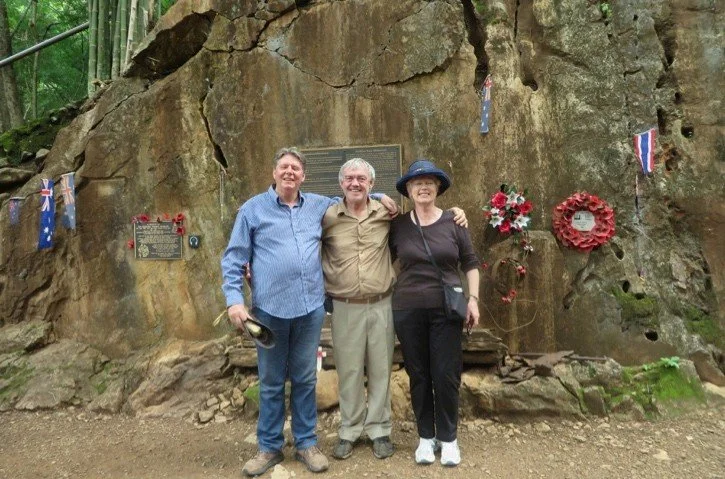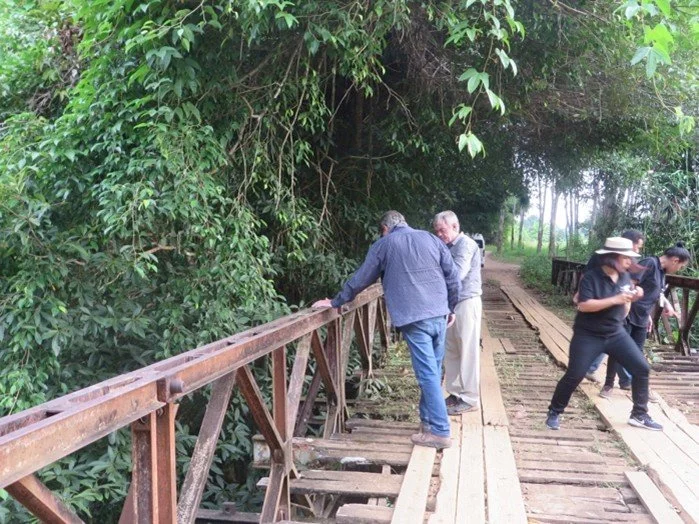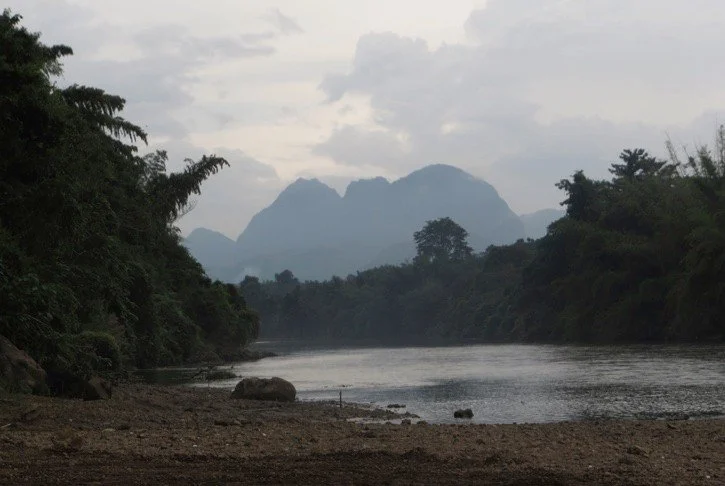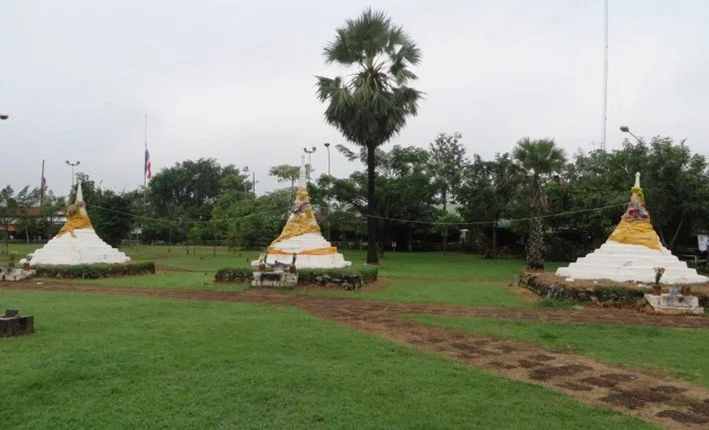Following The Track Of Pond’s Party, On The Burma Railway
Diane Tuck, November 2016
‘It rained frogs’
My father, Stan Rossiter, was one of the POW's of F Force to leave Singapore in April 1943 and disembark in Bampong, Thailand. Dad was in train 2, which later in the march north would join up with train 1 and form "Pond's Party".
Much has been written and officially documented about the very difficult conditions the men endured on that rail trip to Bampong and how conditions deteriorated even further following disembarkation in the jungle.
The personal pilgrimage that my husband Vin and I undertook was planned to specifically track Pond's Party's journey, plus the route of my father's medical evacuation with other sick men on the Kwai Noi and on the completed railway to Kanchanaburi. The staff at The Thailand-Burma Railway Centre (TBRC) planned and carried out our trip perfectly.
There were at least half a dozen sites that stand out for me; sites that were pivotal in dad's recorded account. Having reached Lower Thimongtha according to official records, dad recalls being in a work party up near the border at a place called Nicki, as well as Konkoita, Timonto, and TamarunPah. His spelling in the old worn notebook being vastly different to that of today, but the places he mentions are easily located on today’s detailed map of the railway.
One of the interesting things was to be able to hold the long map that Director of Research of TBRC Rod Beattie had made, as we travelled through the countryside. Rod pointed out the numerous landmarks, campsites, old cemetery sites, railway beds and cuttings, remains of bridges ...all relics of the old Thai-Burma Railway. We stopped at some to hear more detailed information and take photographs.
So, according to dad's diary on "19th June 1943 WORK STOPPED. MARCHING BACK." The group were forced to turn around and march back in difficult conditions from Nicki (Ni Thea) when dad had just succumbed to malaria and dysentery and so began his defining journey, one that was to haunt him to the end of his amazingly long life.
Many miles further on dad and about 40 other very sick men were left at the Swamp Camp - as I call it, but I have read many names for this place - at Tamarunpat by the River Kwai Noi.
Having access to the war diaries of people like Dr. Roy Mills, the courageous and indefatigable young MO of the group, along with various personal stories from other medical staff, camp adjutant, battalion histories and also the contemporary accounts by respected historians, all testify and pay tribute to what happened to Pond's Party.
Despite being aware of all of this, Tamarunpat seemed unreal to me. In recollecting dad's account of the time, and the responses he gave to his youngest granddaughter back in 2002 in an "official' interview, his experience was hard to tally with the official record and diary recollection of others.
He spoke of a terrible place. A place where there was no medicine, yet medical help from Sgt. Boan and his orderlies. Of some food and water, but endless tumbling rain tumbling, and of frogs - many dead frogs lying on the tussocks. "It rained frogs" he said, full of despair. Men he knew were dying around him.
One particular day the medicos decided they were going to move dad to another spot and they shifted his tent fly, but as he couldn't raise the will to move so he just lay there in the mud and rain. Finally he dragged himself to the new spot where, in dad’s word, "they made me buck-up"; in other words they got him going again.
About two months later, when their number was reduced to about half, dad and other survivors were floated out on a barge to "Tarcanoo" - Tha Khanun.
During our pilgrimage this was one of the most enthralling places. We drove up a dirt track a certain distance and then stopped at the bridge opposite a farmhouse and rubber plantation, as we were unable to take the van any further. We walked on, following Rod, who was swinging a machete. I looked at Vin and wondered what lay ahead. We passed over a smaller wooden bridge, then up the track a further 3km or so where we saw the indentations of the railway sleepers. At this point we were walking along the old railway bed.
We then came back a short distance and turned off the track and into a paddock of long grass where we walked for another kilometer and into the bush until we came to a farmer's shanty. Here were chickens running free, with vegetable gardens and further on endless tapioca plants, chilli bushes, more jungle, long grass, bamboo, insects, heat and high humidity.
With assistance, we then scrambled down the face of the cliff and stood high above the river looking down. Then behold - the broken concrete pylons/foundation of the British POW-built bridge that the barely-fit workers of Dr. Mill's Tha Khanun camp of Pond's Party would pass over every day, moving to and from their work area.
Rod spoke more about the camp as we stood on the top of the hill looking down on that part of the river and you could almost feel the spirits around you. (Being fanciful my mother would say). Endless butterflies, dragonflies, and mosquitoes floated about. Looking at the picture on the front of Dr. Mill's diary you can see the wooden trestle bridge in the distance on the right behind his tent surgery.
A second fascinating location was on the return leg of our two-day up-north pilgrimage. On the previous day travelling upriver we had stopped at Tha Sao and had viewed the location where my father's group had stopped marching, bivouacked and marched out again. On return, we turned off the main highway onto yet another dirt track and slowly approached the Kwai Noi, where the whole medical evacuation scenario suddenly became clearer in my mind. Here we were standing on the actual barge landing site where many of the sick men had been sent downriver from places like Tha Khanun - the hospital camp which had been nearby, high on the adjacent hill. From there the men passed to the railway at Wanyai station and onto the long rail trip to the F and H Force camp hospital at Kanchanaburi. We had seen previously where the rail line ran beside the old hospital's site there.
In today's Kanchanaburi there are sporting fields and recreation areas as the local population wouldn't consider living in an area which they thought might be haunted by the many spirits of the men who died there during World war 2.
My father spent many months at Kanchanaburi camp hospital then he was sent onto the Sime Road camp in Singapore in Christmas 1943. The Changi party arrived in May 1944 and was able to bring the remaining F Force men back to the fold. But that was thirteen months away; no wonder it seemed like a holiday camp on return, albeit a very spartan one. This arduous journey somewhat proves my mother's point that dad was a tough old 'coot. Dad's mate Jack Wells, from the 13th AGH in Changi, didn't recognize his friend at first, but how glad he must have been to welcome him back.
Another significant moment for me was in the late afternoon when we arrived at a vast hydroelectric project called the Vachiralongkorn Dam. We had stopped there in the morning en-route to Tha Khanun when Rod had pointed out the locations of the various work camp sites that were now underwater. There, late in the day, those haunting and cruel places my father listed as Konkoita, Nikki, Timonta, Tamarunpat now lay beneath a most peaceful and picturesque body of shimmering water.
For the large number of men who suffered and died in those places it was not to be their final watery resting place as post-war their remains were exhumed and reburied in official war cemeteries in Tanbaya and Kanchanaburi or commemorated on official memorials such as the Kranji Memorial in Singapore. However, standing at the lookout with the late afternoon sun golden on the water I felt I was looking upon a sacred place.
Our five days in and around Kanchanaburi and up north concluded with attending the Remembrance Day service at the War Cemetery there. The officiating Minister was the Rev. Canon J. Clark of Bangkok and there were many local people, visitors and dignitaries in attendance. Many beautiful flowers and wreaths were laid on the central memorial. The lads of Vajiravudh College Pipe Band in their smart uniforms performed while butterflies and dragonflies lazily fluttered about us in the very warm air.
Following the service Vin and I located several of the graves/headstones that Andrew from TBRC had found for us. In dad's notebook/diary, which he had made from old Changi administration gaol documents, there were list of names, most of them from his 2/29th Battalion.
From previous reading I had found that a lot of the men from dad's list hadn't made it back home so we thought we would leave a poppy on each of the graves of those we found in the Kanchanaburi cemetery. This proved to be quite emotional for me as I could only imagine what dad would have been thinking, all these years later.....I recall the line in Eric Bogle's song "The Gift of Years" ‘....hello old friend, well here I am,75 years down the track.........’.
There was one name however, a young sapper from the 2/10th Battalion, with whom dad had shared a tent at Tamarunpat (correct spelling now Tamrong Phatho) that I particularly remembered. Dad had spoken very quietly that he had died. Recalling that moment in the cemetery, I think all the emotion I had been feeling for the last five days became quite overwhelming.
I have tried to give an outline of what our pilgrimage entailed, concentrating on some of the more memorable parts for me. We actually saw many other places, including going up to the Burma border and Three Pagoda Pass, seeing the Hellfire Pass Museum, The Cutting at Chungkai, Tha Makham and later the actual River Kwai bridge and much more.
We had many cultural experiences too with lots of local food and shopping; even a rubber tree latex tapping demonstration by Rod near Tha Khanun. There was also Bow and Poom, the lovely Thai girls who assisted Rod on our trip up north. We appreciated the care that was taken of us both, and the professionalism and friendliness of Rod, Terry and Andrew who run the TBRC and its tours.
I would say to anyone with a POW relative from the Railway, that if you are really interested in delving into the truth of what happened to them and wish to try to make some sense of it all, going on a pilgrimage such as this is very worthwhile, frankly it's probably one of the best things I've experienced in my life. If this sounds like an endorsement for all at the TBRC then so be it.
I now feel I have a better understanding of what occurred over those awful years and feel more at ease with the whole scenario. In the years when dad lived with us for a while, late in his life, I remember feeling quite angry at how much he'd given up to serve his country. At how he came back to find his family hadn't been able to keep the share-farming venture going in his absence, therefore there was no farm to return to. Of how he was still being plagued with nightmares at ninety plus years of age and how this, not only seemed to be, but was in my mind, too harsh and unfair. And then there were the ongoing health issues, which included his ever present, delicate digestive system, which never left him. Even the battles with Veteran Affairs to get a decent pension had taken their toll over the years as they didn't seem to understand that veterans experiencing P.T.S.D symptoms simply cannot cope with that strange bureaucracy.
I think now of how lucky we were that dad came back, went on to marry and have a family and live to 93 years of age. A favourite photograph our family has is of a very proud, smiling, great-grandfather holding his one-year-old great-grandson.
I now have a new image to place with that one. It is of a beautiful reservoir, peaceful and golden-coloured; a fitting end to my pilgrimage and journey of a lifetime.
The following prose is for the men who suffered and died on the Thai Burma Railway. It is also in loving memory of my father who never forgot what happened there.
Swamp Camp By The River
They lay down by the river, with bodies starved and worn;
Sick and dying all around them, little chance to see the dawn.
Forced to build a railway with little more than their bare hands
Senseless violence ever present, they breathed and dreamed of their homeland.
And now they're old and very few, the ones that still march on;
with memories that are still so sad, so vivid and forlorn.
One man looks back in haunting dreams and speaks at last his tale,
As the restless, gentle spirits stir the leaves along the trail.
To my friends still by the river, I won't forget you there.
Your hopes and dreams are still forever at the Swamp Camp by the river.




